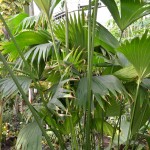
A visit to the temperate zone of the RHS Wisley Garden glasshouse by some of the MSc Plant Diversity students
The RHS garden at Wisley has one of the best curated plant collections in the UK so provided the ideal venue for today’s MSc plant family revision. After a tour of the herbarium and meeting some of the RHS botany staff we walked up to the glasshouse to work through some of the major plant families growing there.
Among familiar families such as Lamiaceae, Acanthaceae and Arecaceae we also picked up some more unusual ones such as Cyclanthaceae and Restionaceae.
Below is a selection of just a few of the plants we saw during the visit. All were well gorwn and in very good condition although a few had caterpillars on from the butterfly display currently in the glasshouse.
- Macaranga grandifolia (Euphorbiaceae) is a native of the Philippines
- Not all Cactaceae have upright stems or cushion forms of growth, this is a trailing species: Lepismium miyagawae.
- Dendrobium fimbriatum var. oculatum (Orchidaceae)
- Ficus pseudopalma in fruit showing the distinctive syconium.
- Musa (Musaceae) in flower and fruit.
- The distinctive blue-green flowers of Strongylodon macrobotrys, the Jade vine (Fabaceae)
- Carludovica palmata is not a palm but a member of the Pandanaceae. The three prominent ribs at the base of the leaf distinguish this genus even when out of flower.
- Carludovica palmata (Cyclanthaceae) looks superficially like a palm but it is related to the Screw Pine family.
- Calathea rufibarba (Marantaceae), a curious furry member of this generally glabrous plant group
- The distinctive prop roots of Pandanus
- Pandanus utilis showing the spirally arranged leaves that give rise to the name Screw Pine.
- Cestrum roseum (Solanaceae) flowers for long periods of the year.
- Cycas debaoensis from China, an unusual cycad with divided pinnules
- Amorphophallus konjac (Araceae) has the distinctive rotting smell of many members of the family.
- Zamia villosa (Zamiaceae) is known as the Poor Man’s Cycad despite its beautiful bright yellow cones.















